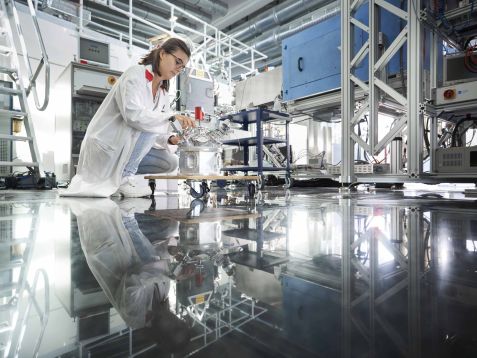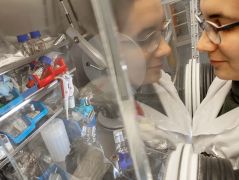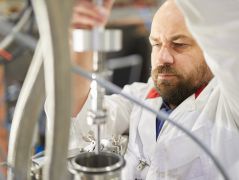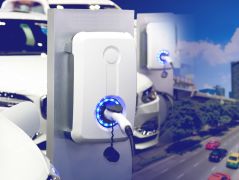MLZ is a cooperation between:
 > Technische Universität München
> Technische Universität München > Helmholtz-Zentrum Hereon
> Helmholtz-Zentrum Hereon
 > Forschungszentrum Jülich
> Forschungszentrum Jülich
MLZ is a member of:
 > LENS
> LENS > ERF-AISBL
> ERF-AISBL
MLZ on social media:

MLZ (eng)
Lichtenbergstr.1
85748 Garching
01.06.2022
On the trail of hydrogen

Laura Guasco has been detecting hydrogen atoms in thin films using neutrons at the reflectometer NREX. © MCQST by Jan Greune
Hydrogen is not only a sustainable fuel in the energy mix, but also plays a key role in neural networks. German and Argentinian researchers at the MLZ have now demonstrated that neutrons are more sensitive than ever before to hydrogen atoms in thin layers and can thus reduce the energy consumption in neural networks in the future.
The human brain is unique in its capacity: It allows us to master a complex process such as playing chess or to process sensory perceptions in a distinctive manner. Nerve cells, so-called neurons, are connected to each other via synapses and exchange information at high speed. Computer science is attempting to emulate the brain in artificial neural networks in order to use them, for example, in medical diagnostics or speech recognition.
Hydrogen atoms reduce energy consumption
“One problem with artificial neurons and synapses, however, is energy consumption. We can reduce this significantly by using materials with hydrogen,” says Dr. Thomas Keller, instrument scientist of the Max Planck Institute for Solid State Research at the Heinz Maier-Leibnitz Zentrum (MLZ).Ultra-low-power artificial synapses are programmed during the learning process by adding hydrogen atoms to them. To do this, researchers apply an electrical voltage that charges or discharges hydrogen from an insulated storage layer into a thin conductive layer in order to change its resistance in a targeted manner.
“Up to now, however we could not properly detect and quantify hydrogen in thin films,” says Laura Guasco from MLZ, doctoral student in the group of Prof. Dr. Bernhard Keimer at the Max Planck Institute for Solid State Research.
Using neutron reflectometry at the MLZ, Guasco and other researchers from the Max Planck Institute for Solid State Research, Forschungszentrum Jülich, Helmholtz Zentrum Berlin and the Laboratorio Argentino de Haces de Neutrones in Argentina analyzed how the hydrogen is distributed in thin layers . “With normal neutron reflectometry, we can reliably measure hydrogen concentrations of 5% with a depth resolution of one nanometer,” explains Guasco. Up to now, real-time experiments have also been limited to slow processes on the order of minutes to hours because of the long exposure times. In spite of this, the neurons in artificial networks tend to react in fractions of a second.
Seconds instead of hours
In their experiments on the MLZ neutron reflectometer NREX, the researchers have now significantly increased the sensitivity of the measurements for real-time experiments in thin films. They examined niobium layers while they were being charged with hydrogen. “We tracked the process of hydrogen loading ten times more sensitively than before. And that on a time scale of a few seconds instead of the hours previously,” reports Guasco.
Advantage of neutrons over X-rays
In addition, the neutrons provide absolute values of the hydrogen concentration – in contrast to X-rays, which only make the hydrogenation process visible indirectly via its influence on the layer thickness. Radiation damage in the material from neutrons is negligible, in contrast to nuclear methods for hydrogen detection, which require high-energy ions. “Another advantage of neutrons: The researchers can carry out investigations in-situ in a hydrogen atmosphere, while other methods often require a high vacuum,” says Guasco and is certain: “With its high sensitivity and its ability to quickly study motion sequences, it has the potential to become a powerful tool for the microscopic understanding and control of hydrogen in solids.” This will also increase the power of neural networks in the future.
Original publication:
Laura Guasco, Yu. N. Khaydukov, S. Pütter, L. Silvi, M. A. Paulin, T. Keller, B. Keimer
Resonant neutron reflectometry for hydrogen detection
Nature Communications, 13, 1486 (2022)
Related News
-
28.06.2021
When hydrogen glows red
-
12.06.2020
Hydrogen – but efficiently
MLZ is a cooperation between:
 > Technische Universität München
> Technische Universität München > Helmholtz-Zentrum Hereon
> Helmholtz-Zentrum Hereon
 > Forschungszentrum Jülich
> Forschungszentrum Jülich
MLZ is a member of:
 > LENS
> LENS > ERF-AISBL
> ERF-AISBL
MLZ on social media:





